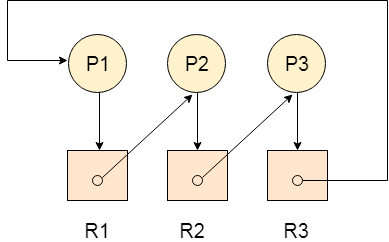Operating System
Process Management
Synchronization
Deadlocks
Memory Management
File Management
Misc
MCQ
Deadlock Detection using RAGIf a cycle is being formed in a Resource allocation graph where all the resources have the single instance then the system is deadlocked. In Case of Resource allocation graph with multi-instanced resource types, Cycle is a necessary condition of deadlock but not the sufficient condition. The following example contains three processes P1, P2, P3 and three resources R2, R2, R3. All the resources are having single instances each. 
If we analyze the graph then we can find out that there is a cycle formed in the graph since the system is satisfying all the four conditions of deadlock. Allocation MatrixAllocation matrix can be formed by using the Resource allocation graph of a system. In Allocation matrix, an entry will be made for each of the resource assigned. For Example, in the following matrix, en entry is being made in front of P1 and below R3 since R3 is assigned to P1.
Request MatrixIn request matrix, an entry will be made for each of the resource requested. As in the following example, P1 needs R1 therefore an entry is being made in front of P1 and below R1.
Avial = (0,0,0)Neither we are having any resource available in the system nor a process going to release. Each of the process needs at least single resource to complete therefore they will continuously be holding each one of them. We cannot fulfill the demand of at least one process using the available resources therefore the system is deadlocked as determined earlier when we detected a cycle in the graph.
Next TopicDeadlock Detection and Recovery
|
 For Videos Join Our Youtube Channel: Join Now
For Videos Join Our Youtube Channel: Join Now
Feedback
- Send your Feedback to [email protected]
Help Others, Please Share









